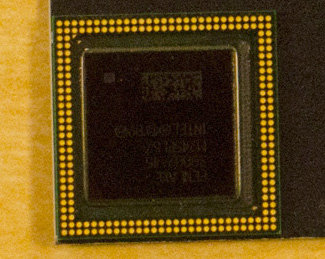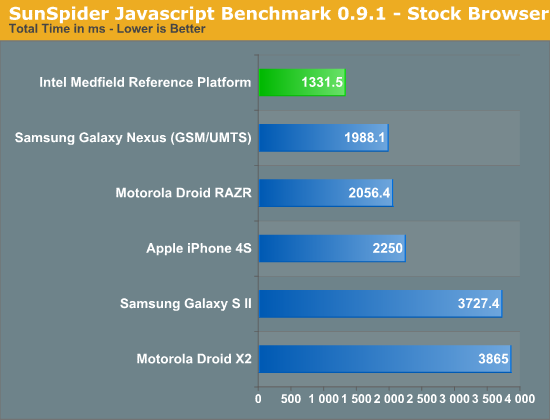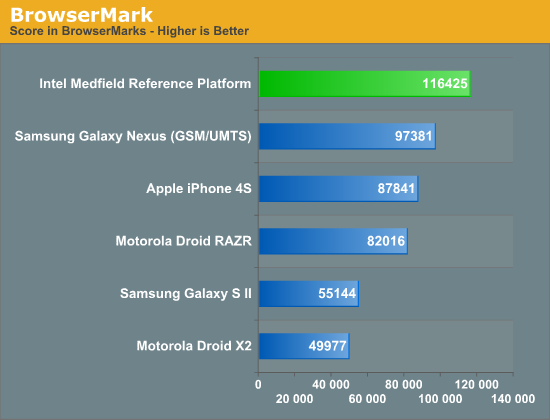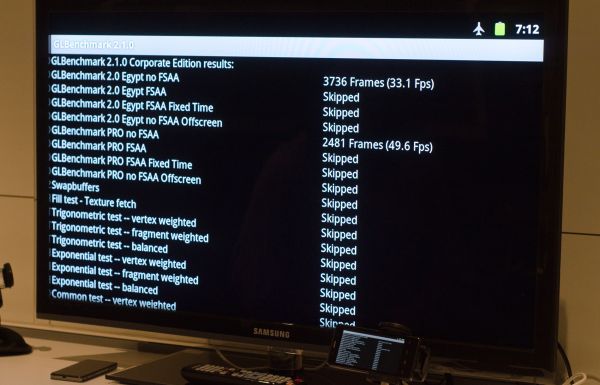Intel's Medfield & Atom Z2460 Arrive for Smartphones: It's Finally Here
by Anand Lal Shimpi on January 10, 2012 8:00 PM ESTIt's here. Intel's first smartphone SoC that you'll actually be able to buy in a device before the end of the year. The platform is called Medfield and Paul Otellini just announced its first device partners.
Medfield starts out as a bonafide mobile SoC. Whereas Moorestown was a "two-chip" solution, Medfield is just one - the Penwell SoC:

The SoC is only available in a PoP (Package on Package) configuration measuring 12mm x 12mm. Intel wouldn't give out a die size but it did show me a Penwell sample without the stacked DRAM:

Since I know the measurements of the package I could estimate the dimensions of the silicon itself. My math worked out to be around 62mm^2. That's larger than a Tegra 2-class SoC, but smaller than Tegra 3 or Apple's A5. The diagram of its high level architecture above helps explain why.
There's only a single version of Medfield being announced today: the Intel Atom Z2460. The Z2460 features a single Atom core with a 512KB L2 cache, a PowerVR SGX 540 GPU and a dual-channel LPDDR2 memory interface. In a world where talking about four Cortex A9s and PowerVR SGX 544MP2s isn't uncommon, Medfield starts out almost sounding a bit...tame. But then you see its performance:

Although running what appears to be a stock Gingerbread browser, Intel's Medfield reference platform posts SunSpider performance better than any other smartphone we've tested - including the Galaxy Nexus running Ice Cream Sandwich. Intel promises that Medfield's performance will scale on ICS as well - the gap should be maintained. We've seen high results from reference designs in the past, but the Medfield platform is a little different as you'll soon see - it's a complete smartphone design that should be representative of handsets that hit the market later this year.
Medfield isn't a one trick pony either, performance is similarly dominating under BrowserMark:

These are tablet-like scores. Here the Galaxy Nexus running ICS comes close, but once again Intel expects that on the same OS Medfield should be faster than any of the currently available SoCs.
I asked Intel where its SunSpider and BrowserMark performance advantages came from, especially considering we've typically only seen huge gains with new browsers and not new SoCs. Their response pointed to a bunch of factors, but one stand out issue was the A9 has a great execution core but seems to be more limited on the memory interface. Atom can support far more outstanding misses in L2 than the Cortex A9, which chokes bandwidth to the processor for anything not already in the L2 cache. This may be one of the reasons why we've never been able to get really high bandwidth numbers out of A9 based SoCs. It's probably safe to assume that things will be different with the Cortex A15, but for now it's little things like this that give Medfield a performance advantage.
GPU performance is understandably not as impressive. We couldn't get offscreen numbers of GLBenchmark 2.1 but we did get results at the device's native resolution (1024 x 600):
3D performance is better than the OMAP 4460 due to Medfield's 400MHz GPU clock compared to ~300MHz in most OMAP4 devices.
Performance without power considerations is meaningless, especially in the smartphone world. Luckily for Intel, Medfield seems very competitive there as well. Intel provided some power and performance data for Medfield based on its reference platform. I still haven't been able to verify any of this for myself, but I was able to see some power tests run in person on the reference platform and competitive devices.
The Intel provided values are pretty astonishing . Sub 20mW idle, sub 750mW during a call on 3G and although not pictured here, Intel's internal data suggests ~1W power consumption while browsing the web compared to ~1.3W on the iPhone 4S and Galaxy S 2. I've done my own measurements on 4S web browsing and came up with a very similar value.
| Intel Measured Smartphone Power Consumption (Identical Display Brightness) | ||||||
| Standby (3G) | Talk (3G) | Browsing (3G) | Video Playback 720p | |||
| Apple iPhone 4S | ~38mW | ~800mW | ~1.3W | ~500mW | ||
| Intel Medfield Reference | ~18mW | ~700mW | ~1.0W | ~850mW | ||
| Samsung Galaxy S II | ~19mW | ~675mW | ~1.2W | ~650mW | ||
The performance and power data both look great for Medfield. You would think that this data, assuming there's nothing fundamentally wrong, would be enough to convince a handset maker to actually give Intel a shot. You'd be right.
In addition to disclosing Medfield performance data, Intel is also announcing partnerships with both Motorola and Lenovo. The former is a broad, multi-year agreement stating that Motorola plans on creating many devices based on Intel silicon - the first of which will be a smartphone due out before the end of the year. Tablets will follow at some point as well.
Lenovo on the other hand will actually be taking and tweaking Intel's own Medfield reference platform, and releasing it in China in Q2.
All of this is exactly what Intel needed: a start.











164 Comments
View All Comments
hechacker1 - Tuesday, January 10, 2012 - link
What's impressive to me is the fact that you have an Atom, which powers generations of netbooks, running as a SoC using only milliwatts of power most of the time.I'd love to see a tablet/netbook version with a huge battery that could run for the better part of a day.
It would even do really well as a media server/HTPC if only it had I/O bandwidth for hard disks and HDMI outputs with surround sound.
aNYthing24 - Tuesday, January 10, 2012 - link
Not really all that impressed. By the time it's out, you'll start seeing phones ARM Cortex-A15 based SoCs which are about 40-50% faster than Cortex-A9 based SoCs.MonkeyPaw - Tuesday, January 10, 2012 - link
Yeah, I'm still on the naysayer's side, too. The SOC market isn't as slow to develop as x86. We've seen rapid improvements over the course of the last 4 years. Where the next generation of x86 may get you 15% more performance (if you can even utilize it all), SOC's are gaining in relative leaps and bounds, and the improved performance is quite noticeable. I went from an iPhone3G to an iPhone4, and every aspect of performance was clearly better. Everything loads faster, you can "multitask" and take better pictures and HD video, and the battery life is still better. That was in 3 years time. 3 years from now looks to be just as positive. That means Intel has the tougher road. It took them 5 long years to get Atom DOWN to sub 1W TDP and into a phone, while ARM SOCs have always been working inside this power design.That said, I sure as heck hope this doesn't fowl up Android Market any further. I've said it before, App compatibility is already not a given due to OS version fragmentation. Adding x86 will just require more effort on the developer's part, which might doom Intel's early chances anyway.
Rest assured, Intel will dump billions into this and not go away. They can't afford to miss out on this market. I wonder when AMD will figure that one out...
yvizel - Wednesday, January 11, 2012 - link
Clearly shows how little do you know... WOW.Griswold - Thursday, January 12, 2012 - link
He may know little, whereas you know NOTHING.Back under your rock, peanut.
stadisticado - Wednesday, January 11, 2012 - link
I gotta say...I really disagree with your assessment. ARM SOCs have indeed improved a lot over the past few gens. However, that is largely due to moving to new nodes, going from single to double to quad core uarch and finally in moving up the ladder on ARM architectures. Now, Intel is jumping in here, let's assess along these vectors:I don't think anyone is arguing Intel has process leadership, perhaps not in SOC, but at least their 32nm node is competing directly with TSMC 28nm.
As for the core wars, I predict Intel goes the route they go in laptops: dual core with HT is the right balance of perf/power for most applications. That said, I guarantee we see quad cores with HT for tablets in 2013 on 22nm.
The uarch question is yet to be answered. Ultimately we'll have to see how A15 stacks up against this single core Saltwell and the dual core that's coming in the Clovertrail platform.
name99 - Wednesday, January 11, 2012 - link
What Intel naysayers (at least the ones that aren't twelve years old) say is that x86 complexity puts SEVERE constraints on how fast Intel can spin these chips around. It took something like 7 years for Nehalem to move from initial design to fully validated and ready to ship.Now, in the "traditional" x86 space, this has not been that much of a problem for Intel for a while because they run so much design in parallel, so that each team has its new CPU ready each year. Even so it does occasionally cause problems when Intel misjudges where things will be in the future and misses a feature for a few years. The most obvious example of this was x86-64, but we saw it again regarding moving the memory controller on-die, and regarding how powerful users expect on-chip GPUs to be.
So, when it comes to Atom:
(a) do they have multiple design teams in place, so that we can now expect a steady rate of serious improvement every year. Or is this the fruit of their one major design team, and we can expect it to stand still, apart from minor tweaks, for the next three years or so?
(b) are they willing to modify the SOC as requested by different vendors, to improve power or reduce size? What if I want a custom flash controller on the SOC or a better than average camera processor? Maybe this doesn't matter --- but maybe it does. I think honestly none of us know. What we DO know is that the phone market is different from the old-school PC market. Unlike old school PCs, size (fewer parts) and power (better integrated parts) matter a huge amount, which gives an advantage to CPU vendors who are willing to tailor their SOCs to include anything extra the manufacturer wants, while tossing anything they don't want.
Finally: "ARM SOCs have indeed improved a lot over the past few gens. However, that is largely due to moving to new nodes, going from single to double to quad core uarch and finally in moving up the ladder on ARM architectures. Now, Intel is jumping in here, let's assess along these vectors:"
This process (for ARM) has not stopped. ARM-64 is a COMPLETELY new architecture, optimized for power and performance based on everything ARM has learned over the past few years, and tossing various components of the architecture that no longer make sense. ARM-64 devices plan (as far as I know) to be compatible, during the brief period that is necessary, to have a separate ARM-32 core on die to handle ARM-32 binaries --- no crippling of either the ARM-64 architecture or the core design in order to allow 32-bit binaries to still work with it.
The point is that ARM is both improving their underlying architecture aggressively, AND that they are doing everything they can to ensure that they can remain nimble and easily able to spin out new cores with new ideas as the market evolves. Compare with Intel and their 7 year design cycles...
stadisticado - Wednesday, January 11, 2012 - link
On the 7 year design cycle: How long ago did ARM Holdings start RnD on A15? Whats the cycle time for that product to go from scratch to inside a product? That 7 year cycle you're quoting is literally from the first time the name showed up in a design document to ship, which I don't feel is a good comparative metric, especially for SoCs which share multiple common blocks across gens.Does Intel have more design teams on Atom? No idea - but looking at the roadmap they have Atom on they basically have to. One team is not capable of spinning Medfield and pushing the 22nm Atom out the door next year and then 14nm the year after.
Basically you're stipulating that ARM is inherently faster than Intel in this space. Its yet to be demonstrated but I'm stipulating that is going to turn out to be a bad assumption.
PubFiction - Thursday, January 12, 2012 - link
Intel did not have a good dedication to atom but they are now getting there. So ARM obviously had the advantage before. Intel considered Atom second rate stuff to put on old nodes.Also while the design of a full desktop CPU is long from start to finish I do not think it has anything to do with x86. It is more about just competing at the highest end. Itanium was no walk in the park. And so far no other architecture has beat x86. At the very least it still takes anyone else a long time to design chips.
The reason ARM moves faster is their chips are so much more simple. And atom is moving in that direction.
Intel is a scary competitor for anyone in any processor space. Once they dedicate to something it will get competitive. Does not mean they will win, but if these chips have this performance and actually do ship this year it they may not beat A15 but they will be good enough to stick in phones. And that is the start intel needs.
zeo - Saturday, January 14, 2012 - link
Yes, Intel had the ATOM on a slow 5 year product cycle but now they are switching it to a 2 year cycle for similar rate of advancement as Intel's higher end chip offerings.The 22nm Silvermont update coming out in 2013 will be when the switch is official and we can start expecting the usual year by year tic toc of advancement.
For example, Silvermont is more than just another die shrink but also the first major architectural change for the ATOM. Like Out Of Order Processing, as well as adding new technology like Intel's Tri-Gate Transistors.
Intel ATOMs also will be supporting a range of 1 to 8 cores. The 8 core version presently being focused for the server market, but it's likely Intel will leverage multiple cores for most of their intended product lines.
Cedar Trail is for example dual core for both the high end and low end chip versions.
While the Clover Trail and Medfield shows Intel is making progress of SoC and improving power efficiency to be at least good enough to start competing in the mobile market.
Though we still have to see if Intel can be price competitive and Intel will likely need to offer even better performance than ARM can offer with their next gen offerings to start to really expand into the mobile market. So Intel has a lot riding on coming through in 2013.